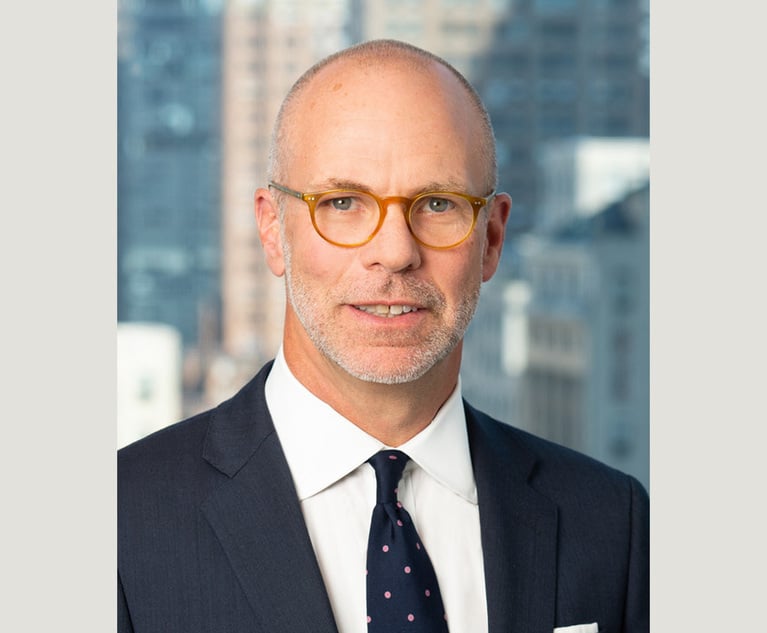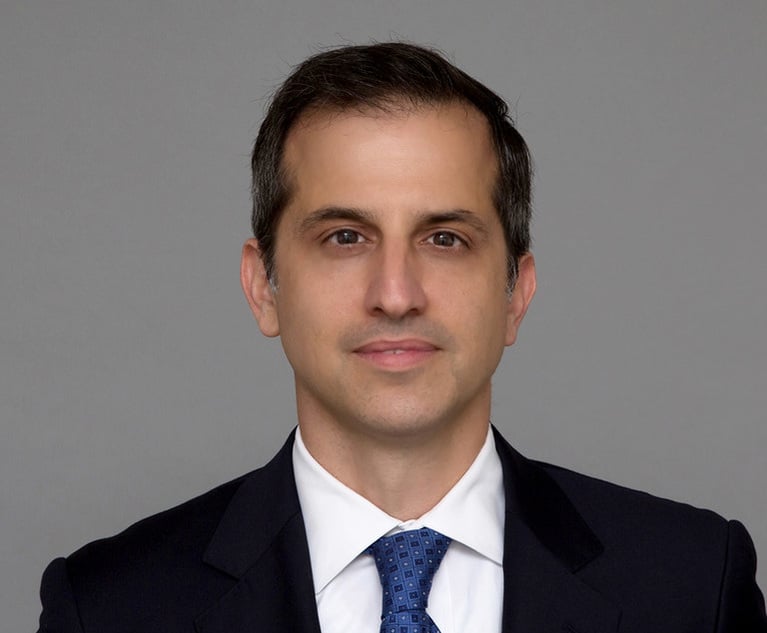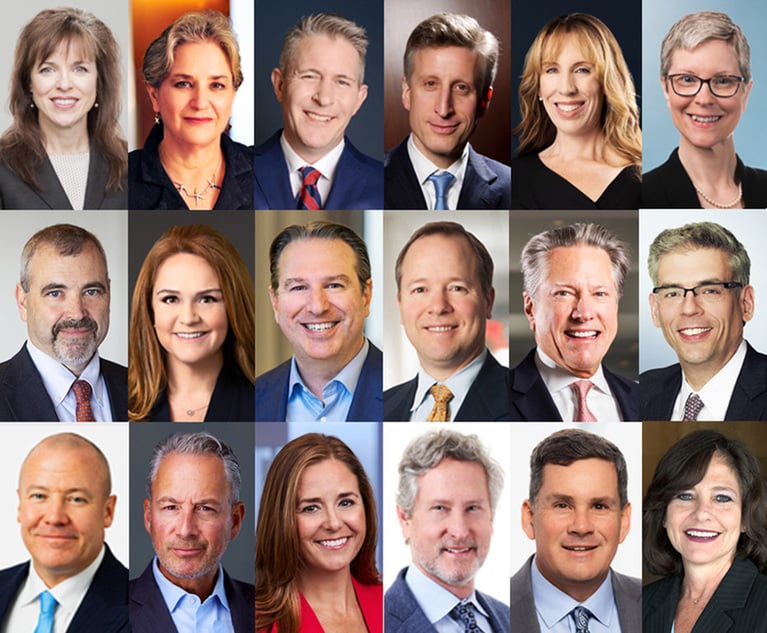Litigation Funding Icon Changes Its Strategy as Capital Pours In
Howard Shams is readying Parabellum Capital for a day when litigation finance becomes “commoditized.”
September 25, 2018 at 02:53 PM
7 minute read
The original version of this story was published on The American Lawyer

One of the first times Howard Shams asked a law firm about financing some of its litigation, its partners were reluctant to talk about the case he liked. Instead, the lawyers pushed toward him a case they knew had a much lower chance of success.
“I said, 'That's so adverse selective,'” said Shams, recalling an episode from his days at Credit Suisse AG, where he ran one of the financial services firm's earliest books investing in litigation. “They were not even embarrassed by it.”
Flash forward roughly a decade, and Shams is readying himself and his firm, Parabellum Capital, for what he sees as a new adverse selection problem bubbling up in his industry.
Simply put, at some point, there will be too much money looking to invest in too few cases.
Litigation funding has never been more en vogue to the investor class. Major funders in the United States have announced raising $1.75 billion over the past two years. Since the start of 2017, at least eight entities have raised more than $100 million to invest in litigation. There were three capital raises of that size in the three years prior.
 Howard Shams.
Howard Shams.
Shams is one of the few litigation funding insiders who said he is preparing for a market where this growth will eventually lead to “commoditized” capital in the litigation finance space. In other words, a time when funders are competing on price or on deal terms in order to invest in profitable cases. As a result, the outsize returns that funders have enjoyed—often demanding three to six times their investments—will shrink.
“When everybody is looking [to invest in] a limited number of cases, you have to figure out how you're not going to be involved in a bidding war with someone who's going to do stupid things because they've got to deploy capital,” Shams said in a recent interview with The American Lawyer.
His solution is what Shams calls a “pivot toward clients,” or towards marketing his money toward companies.
Shams wants to displace law firm partners as corporations' go-to source for hiring litigators. By hiring law firms through Parabellum, argued Shams, clients will get deals that maximize their potential returns and they will work with the best firms for plaintiffs work. Parabellum, meanwhile, will get a first look at the best cases.
“What we're messaging to the market is not that there is commoditized capital today, but that the growth [in litigation finance] has to be inside great risk-taking law firms, of which there are candidly a limited amount, and it has to be, two, inside claimholders themselves,” Shams said.
Shams and Parabellum are far from the lone litigation funder who are marketing their services directly to blue-chip companies and other corporations.
Burford Capital Ltd. announced in 2016 that it had invested $45 million in a portfolio of cases pursued by one company, which news reports later pegged as U.K. telecommunications giant BT Group plc. But deals that are sourced directly from companies are otherwise hard to find, owing to the secrecy of the industry.
Still, nearly all the biggest players in the industry such as IMF Bentham Ltd., Longford Capital Management and Validity Finance have all expressed a desire to source deals directly from companies. Ralph Sutton, a former colleague of Shams at Credit Suisse who launched Validity Finance earlier this year, said he believes growth in the industry will be determined by who provides the best experience for claimholders.
 Ralph Sutton.
Ralph Sutton.
“The third wave of growth [in litigation finance] is focused on the clients and creating value for them,” Sutton said. “And that's what we need to focus on: Who are the funders who put the clients first.”
At a presentation in New York this summer, William Strong, chairman of Longford Capital, said that the future of litigation finance would include funding an “increasing number of corporate portfolios.”
Still, what is different about Shams' messaging is his blunt assessment that the industry will at some point reach a level of capital that will force returns lower. Most litigation finance leaders do not agree, or at least not publicly.
“Over time, eventually, there may be some downward price pressure,” Sutton said. “But it's still so early.”
Christopher Bogart, CEO of Burford Capital, said the effect increased levels of capital has on the pricing of litigation funding is “widely misunderstood in the industry.” Pricing of the cases must be based on their underlying risk, he said.
“The dynamic is not one of saying, 'Gee, there are more people doing this now so for the same risk the price should be lower,'” Bogart said. “All that does is guarantee you that you won't generate the returns that will get you the capital.”
Shams also believes that corporations hiring law firms through a litigation funder will ensure that clients are working with firms that understand how to staff and pursue plaintiffs-side litigation. Most Big Law litigation departments are much more accustomed to billing hours on defense cases. And from the funders' perspective, it ensures that Parabellum will work with firms who are investing in their clients' cases rather than using litigation finance to extend a billable hour model, Shams said.
“When law firms are thinking, 'How can I act like I'm on the billable hour even though I'm technically working on contingency fee?' I call that adverse selection. I call that misalignment. I call that a bad situation,” Shams said. “We anticipate that the law firms who are really great practitioners of plaintiffs work are different than those out there looking to get their piece of some cheap capital.”
There is still a question of whether blue-chip companies are ready to engage litigation funders as a one-stop shop for financing their cases and hiring their lawyers.
On that point, most in the industry believe the transition will take time.
This content has been archived. It is available through our partners, LexisNexis® and Bloomberg Law.
To view this content, please continue to their sites.
Not a Lexis Subscriber?
Subscribe Now
Not a Bloomberg Law Subscriber?
Subscribe Now
NOT FOR REPRINT
© 2025 ALM Global, LLC, All Rights Reserved. Request academic re-use from www.copyright.com. All other uses, submit a request to [email protected]. For more information visit Asset & Logo Licensing.
You Might Like
View All
Big Company Insiders See Technology-Related Disputes Teed Up for 2025

Litigation Leaders: Jason Leckerman of Ballard Spahr on Growing the Department by a Third Via Merger with Lane Powell

Litigation Leaders: Greenspoon Marder’s Beth-Ann Krimsky on What Makes Her Team ‘Prepared, Compassionate and Wicked Smart’
Trending Stories
Who Got The Work
Michael G. Bongiorno, Andrew Scott Dulberg and Elizabeth E. Driscoll from Wilmer Cutler Pickering Hale and Dorr have stepped in to represent Symbotic Inc., an A.I.-enabled technology platform that focuses on increasing supply chain efficiency, and other defendants in a pending shareholder derivative lawsuit. The case, filed Oct. 2 in Massachusetts District Court by the Brown Law Firm on behalf of Stephen Austen, accuses certain officers and directors of misleading investors in regard to Symbotic's potential for margin growth by failing to disclose that the company was not equipped to timely deploy its systems or manage expenses through project delays. The case, assigned to U.S. District Judge Nathaniel M. Gorton, is 1:24-cv-12522, Austen v. Cohen et al.
Who Got The Work
Edmund Polubinski and Marie Killmond of Davis Polk & Wardwell have entered appearances for data platform software development company MongoDB and other defendants in a pending shareholder derivative lawsuit. The action, filed Oct. 7 in New York Southern District Court by the Brown Law Firm, accuses the company's directors and/or officers of falsely expressing confidence in the company’s restructuring of its sales incentive plan and downplaying the severity of decreases in its upfront commitments. The case is 1:24-cv-07594, Roy v. Ittycheria et al.
Who Got The Work
Amy O. Bruchs and Kurt F. Ellison of Michael Best & Friedrich have entered appearances for Epic Systems Corp. in a pending employment discrimination lawsuit. The suit was filed Sept. 7 in Wisconsin Western District Court by Levine Eisberner LLC and Siri & Glimstad on behalf of a project manager who claims that he was wrongfully terminated after applying for a religious exemption to the defendant's COVID-19 vaccine mandate. The case, assigned to U.S. Magistrate Judge Anita Marie Boor, is 3:24-cv-00630, Secker, Nathan v. Epic Systems Corporation.
Who Got The Work
David X. Sullivan, Thomas J. Finn and Gregory A. Hall from McCarter & English have entered appearances for Sunrun Installation Services in a pending civil rights lawsuit. The complaint was filed Sept. 4 in Connecticut District Court by attorney Robert M. Berke on behalf of former employee George Edward Steins, who was arrested and charged with employing an unregistered home improvement salesperson. The complaint alleges that had Sunrun informed the Connecticut Department of Consumer Protection that the plaintiff's employment had ended in 2017 and that he no longer held Sunrun's home improvement contractor license, he would not have been hit with charges, which were dismissed in May 2024. The case, assigned to U.S. District Judge Jeffrey A. Meyer, is 3:24-cv-01423, Steins v. Sunrun, Inc. et al.
Who Got The Work
Greenberg Traurig shareholder Joshua L. Raskin has entered an appearance for boohoo.com UK Ltd. in a pending patent infringement lawsuit. The suit, filed Sept. 3 in Texas Eastern District Court by Rozier Hardt McDonough on behalf of Alto Dynamics, asserts five patents related to an online shopping platform. The case, assigned to U.S. District Judge Rodney Gilstrap, is 2:24-cv-00719, Alto Dynamics, LLC v. boohoo.com UK Limited.
Featured Firms
Law Offices of Gary Martin Hays & Associates, P.C.
(470) 294-1674
Law Offices of Mark E. Salomone
(857) 444-6468
Smith & Hassler
(713) 739-1250







